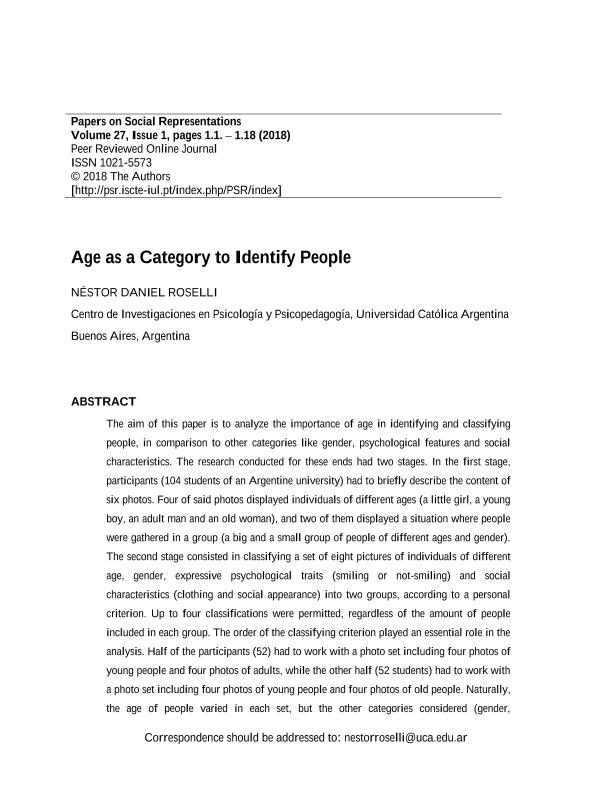Mostrar el registro sencillo del ítem
dc.contributor.author
Roselli, Nestor Daniel

dc.date.available
2022-07-22T15:03:05Z
dc.date.issued
2018-05
dc.identifier.citation
Roselli, Nestor Daniel; Age as a category to identify people; University Institute of Lisbon; London School of Economics and Political Science; Johannes Kepler Universität Linz; Papers on Social Representations; 27; 1; 5-2018; 1-18
dc.identifier.issn
1021-5573
dc.identifier.uri
http://hdl.handle.net/11336/162923
dc.description.abstract
The aim of this paper is to analyze the importance of age in identifying and classifying people, in comparison to other categories like gender, psychological features and social characteristics. The research conducted for these ends had two stages. In the first stage, participants (104 students of an Argentine university) had to briefly describe the content of six photos. Four of said photos displayed individuals of different ages (a little girl, a young boy, an adult man and an old woman), and two of them displayed a situation where people were gathered in a group (a big and a small group of people of different ages and gender). The second stage consisted in classifying a set of eight pictures of individuals of different age, gender, expressive psychological traits (smiling or not-smiling) and social characteristics (clothing and social appearance) into two groups, according to a personal criterion. Up to four classifications were permitted, regardless of the amount of people included in each group. The order of the classifying criterion played an essential role in the analysis. Half of the participants (52) had to work with a photo set including four photos of young people and four photos of adults, while the other half (52 students) had to work with a photo set including four photos of young people and four photos of old people. Naturally, the age of people varied in each set, but the other categories considered (gender, psychological traits and social characteristics) were the same in both sets. Results showed that age was an important reference to categorize and classify people, at least for young people, and especially when the chronological distance was greater. Gender and, to a lesser degree, sociological and psychological features were also important.
dc.format
application/pdf
dc.language.iso
eng
dc.publisher
University Institute of Lisbon; London School of Economics and Political Science; Johannes Kepler Universität Linz
dc.rights
info:eu-repo/semantics/openAccess
dc.rights.uri
https://creativecommons.org/licenses/by-nc-sa/2.5/ar/
dc.subject
AGE
dc.subject
SOCIAL REPRESENTATIONS
dc.subject
PEOPLE
dc.subject.classification
Psicología

dc.subject.classification
Psicología

dc.subject.classification
CIENCIAS SOCIALES

dc.title
Age as a category to identify people
dc.type
info:eu-repo/semantics/article
dc.type
info:ar-repo/semantics/artículo
dc.type
info:eu-repo/semantics/publishedVersion
dc.date.updated
2022-07-20T16:04:26Z
dc.journal.volume
27
dc.journal.number
1
dc.journal.pagination
1-18
dc.journal.pais
Portugal

dc.description.fil
Fil: Roselli, Nestor Daniel. Consejo Nacional de Investigaciones Científicas y Técnicas; Argentina. Pontificia Universidad Católica Argentina "Santa María de los Buenos Aires". Facultad de Psicología y Psicopedagogía. Centro de Investigaciones en Psicología y Psicopedagogía; Argentina
dc.journal.title
Papers on Social Representations
dc.relation.alternativeid
info:eu-repo/semantics/altIdentifier/url/https://psr.iscte-iul.pt/index.php/PSR/article/view/458
Archivos asociados
